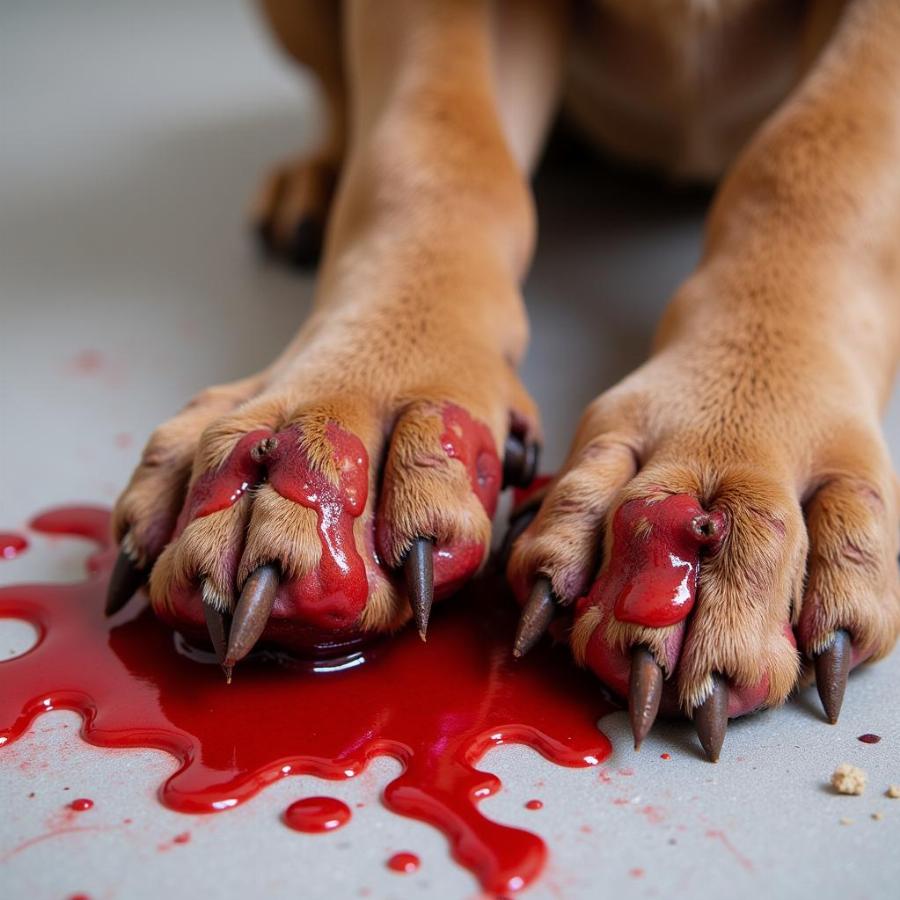Seeing blood in your dog’s poop can be alarming. This is a serious issue and warrants immediate attention. While not every instance signifies a life-threatening condition, it’s crucial to understand the potential causes and know when to seek veterinary care. This guide aims to provide dog owners with the information they need to navigate this worrisome situation.
Understanding Blood in Dog Stool: Causes and Concerns
Blood in a dog’s stool, medically known as hematochezia, can manifest in various ways, from bright red streaks to darker, almost black stools (melena). The color and consistency can offer clues about the source of the bleeding. Bright red blood often indicates bleeding in the lower digestive tract, such as the colon or rectum. Darker, tarry stools suggest bleeding higher up in the digestive system, possibly the stomach or small intestines.
Several factors can contribute to blood in your dog’s poop. These range from relatively minor issues like dietary indiscretion (eating something they shouldn’t) to more serious conditions such as parasites, bacterial infections, inflammatory bowel disease (IBD), and even cancer.
What are the common culprits? Dietary changes, stress, food allergies, or simply eating something that irritates their digestive system can lead to temporary bloody stool. However, more serious conditions like parvovirus, hemorrhagic gastroenteritis (HGE), and intestinal blockages require immediate veterinary intervention.
 Dog with bright red blood in stool
Dog with bright red blood in stool
When to Seek Veterinary Care for a Dog with Bloody Stool
While occasional small amounts of blood might not always be an emergency, it’s essential to err on the side of caution. If your dog exhibits any of the following symptoms along with bloody stool, contact your veterinarian immediately:
- Lethargy or weakness
- Vomiting
- Loss of appetite
- Abdominal pain or distension
- Pale gums
- Increased thirst
- Straining to defecate
- Changes in bowel habits (diarrhea or constipation)
These accompanying symptoms could indicate a more serious underlying condition requiring prompt diagnosis and treatment. Delaying veterinary care can potentially worsen the situation and lead to more severe complications.
Diagnosing the Cause of Blood in Your Dog’s Poop
Your veterinarian will conduct a thorough examination and may recommend diagnostic tests to determine the cause of the bleeding. These tests might include:
- Fecal examination: To check for parasites and bacteria.
- Blood tests: To assess overall health and organ function.
- X-rays or ultrasound: To visualize the digestive tract and identify potential blockages or tumors.
- Endoscopy or colonoscopy: To examine the lining of the digestive tract and obtain tissue samples for biopsy if necessary.
Once the cause is identified, your veterinarian can develop a tailored treatment plan to address the underlying issue and alleviate your dog’s symptoms.
Preventing Blood in Dog Stool
While not all causes are preventable, you can take steps to minimize the risk:
- Feed a high-quality, balanced diet. Avoid sudden dietary changes and table scraps.
- Keep your dog’s environment clean and free of toxins and potential hazards.
- Administer regular parasite prevention medication.
- Monitor your dog’s bowel movements for any changes in color, consistency, or frequency.
- Address any underlying health conditions promptly.
Conclusion: Addressing Blood in Your Dog’s Poop Proactively
Seeing blood in your dog’s poop is a cause for concern. While some causes are relatively minor and easily treated, others can be more serious and require immediate veterinary attention. By understanding the potential causes, recognizing warning signs, and seeking timely veterinary care, you can help ensure your furry friend receives the necessary treatment and returns to optimal health. Never hesitate to contact your veterinarian if you notice blood in your dog’s stool. Early diagnosis and intervention can significantly improve the outcome and prevent potential complications.
FAQs: Common Questions About Blood in Dog Poop
-
What does bright red blood in dog poop mean? Bright red blood often signifies bleeding in the lower digestive tract, such as the colon or rectum. It can be caused by various factors, including dietary indiscretion, colitis, or rectal polyps.
-
Is dark, tarry stool in dogs an emergency? Yes, dark, tarry stool (melena) is often a sign of bleeding higher up in the digestive system and requires immediate veterinary attention.
-
Can stress cause blood in dog poop? Yes, stress can sometimes lead to colitis, which can cause bloody stool.
-
What should I do if my dog has blood in their poop and is vomiting? Contact your veterinarian immediately, as these symptoms together can indicate a serious underlying condition.
-
How is blood in dog stool diagnosed? Your veterinarian will perform a physical examination and may recommend diagnostic tests such as fecal examination, blood tests, X-rays, ultrasound, or endoscopy.
-
Can dog food allergies cause blood in stool? Yes, food allergies can cause inflammation in the digestive tract, leading to bloody stool.
-
Is blood in dog poop always a sign of a serious problem? Not always, but it’s always best to consult your veterinarian to rule out any serious underlying conditions.
Related Topics on Beaut Dogs
For more information on related topics, check out these articles: heartworms in dog poop, dog blood in stool, why do dogs eat their throw up, dog throwing up food undigested, and rice dog poop.
Beaut Dogs is your trusted resource for all things canine, providing expert advice and valuable information on dog breeds, care, health, and nutrition. We’re dedicated to helping you navigate the world of dog ownership and ensuring the well-being of your beloved companion. For further assistance and personalized advice, please contact us at [email protected]. We at Beaut Dogs are here to help!